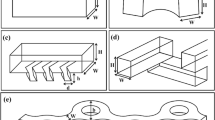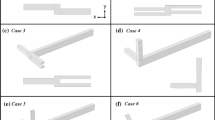Abstract
Micromixing has a wide range of biomedical and biochemical applications. Therefore, many researchers have studied this type of microfluidic devices and have attempted to propose a design with better efficiency. Micromixers are classified as passive and active based on their mixing method (whether external energy source is used to improve mixing or not). The active micromixers have attracted the attentions due to their simple configuration and higher efficiency compared with the passive ones. Induced charge electrokinetic (ICEK) micromixers are the active mixers which have introduced in the recent decade. In the present paper, a novel ICEK micromixer is presented in which two hurdles are placed in the micro-chamber of a micromixer. After determining the efficient configuration for the hurdles, the optimized position of these two hurdles in the microchamber is determined by Nelder–Mead optimization algorithm.







Similar content being viewed by others
References
Bazargan-Lari Y (2019) Design and shape optimization of MR brakes using Nelder–Mead optimization algorithm. Mech Ind 20(6):602
Bockelmann H, Heuveline V, Barz DP (2012) Optimization of an electrokinetic mixer for microfluidic applications. Biomicrofluidics 6(2):024123
Bordbar A et al (2018) Slug flow in microchannels: numerical simulation and applications. J Ind Eng Chem 62:26–39
Bordbar A et al (2020) High-viscosity liquid mixing in a slug-flow micromixer a numerical study. J Flow Chem 10:449–459
Bordbar A, Kamali R, Taassob A (2020) Thermal performance analysis of slug flow in square microchannels. Heat Transf Eng 41(1):84–100
Cai G et al (2017) A review on micromixers. Micromachines 8(9):274
Chen X, Li T (2017) A novel passive micromixer designed by applying an optimization algorithm to the zigzag microchannel. Chem Eng J 313:1406–1414
Chen X, Shen J (2017) Numerical analysis of mixing behaviors of two types of E-shape micromixers. Int J Heat Mass Transf 106:593–600
Chen X, Zhang L (2017) A review on micromixers actuated with magnetic nanomaterials. Microchim Acta 184(10):3639–3649
Chen X, Zhao Z (2017) Numerical investigation on layout optimization of obstacles in a three-dimensional passive micromixer. Anal Chim Acta 964:142–149
Chen X et al (2016) Numerical and experimental investigation on micromixers with serpentine microchannels. Int J Heat Mass Transf 98:131–140
Daghighi Y, Li D (2013) Numerical study of a novel induced-charge electrokinetic micro-mixer. Anal Chim Acta 763:28–37
Dehghan Manshadi MK et al (2016) Electroosmotic micropump for lab-on-a-chip biomedical applications. Int J Numer Model Electron Netw Devices Fields 29(5):845–858
Deshmukh S, Vlachos D (2005) Novel micromixers driven by flow instabilities: application to post-reactors. AIChE J 51(12):3193–3204
Gambhire S et al (2016) A review on different micromixers and its micromixing within microchannel. Int J Curr Eng Technol 4(4):409–413
Hadidi H, Kamali R, Manshadi MK (2019) Numerical simulation of a novel non-uniform electric field design to enhance the electrocoalescence of droplets. Eur J Mech B Fluids 80:206–215
Kamali R, Manshadi MKD (2016) Numerical simulation of the leaky dielectric microdroplet generation in electric fields. Int J Mod Phys C 27(01):1650012
Kamali R, Mansoorifar A, Manshadi MD (2014) Effect of baffle geometry on mixing performance in the passive micromixers. Iran J Sci Technol Trans Mech Eng 38(M2):351
Kamali R, Manshadi MKD, Mansoorifar A (2016) Numerical analysis of non Newtonian fluid flow in a low voltage cascade electroosmotic micropump. Microsyst Technol 22(12):2901–2907
Khojasteh D et al (2020) Electrically modulated droplet impingement onto hydrophilic and (super) hydrophobic solid surfaces. J Brazil Soc Mech Sci Eng 42(4):1–11
Kim D et al (2005) An easily integrative and efficient micromixer and its application to the spectroscopic detection of glucose-catalyst reactions. Analyst 130(3):293–298
Klein K, Neira J (2014) Nelder-mead simplex optimization routine for large-scale problems: a distributed memory implementation. Comput Econ 43(4):447–461
Lee NY, Yamada M, Seki M (2005) Development of a passive micromixer based on repeated fluid twisting and flattening, and its application to DNA purification. Anal Bioanal Chem 383(5):776–782
Lee C-Y et al (2011) Microfluidic mixing: a review. Int J Mol Sci 12(5):3263–3287
Mae K et al (2004) Development of a new micromixer based on split/recombination for mass production and its application to soap free emulsifier. Chem Eng J 101(1–3):31–38
Manshadi MKD et al (2016) Efficiency enhancement of ICEK micromixer by a rectangular obstacle. In: 3rd annual international conference on new research achievements in chemistry and chemical engineering. Ferdowsi University of Mashhad, Tehran.
Manshadi MK et al (2018) Delivery of magnetic micro/nanoparticles and magnetic-based drug/cargo into arterial flow for targeted therapy. Drug Deliv 25(1):1963–1973
Manshadi MKD et al (2019a) Numerical analysis of non-uniform electric field effects on induced charge electrokinetics flow with application in micromixers. J Micromech Microeng 29(3):035016
Manshadi MK et al (2019b) Magnetic aerosol drug targeting in lung cancer therapy using permanent magnet. Drug Deliv 26(1):120–128
Manshadi MK et al (2019c) Numerical analysis of non-uniform electric field effects on induced charge electrokinetics flow with application in micromixers. J Micromech Microeng 29(3):035016
Manshadi MKD et al (2020) Induced-charge electrokinetics (ICEK) in microfluidics: a review on recent advancements. J Micromech Microeng 30(11):113001
Pekker L, Young M (2011) Model of ideal electrohydrodynamic thruster. J Propul Power 27(4):786–792
Poscharny K et al (2018) Machine assisted reaction optimization: a self-optimizing reactor system for continuous-flow photochemical reactions. Tetrahedron 74(25):3171–3175
Rashidi S et al (2018) A review on the application, simulation, and experiment of the electrokinetic mixers. Chem Eng Process Process Intensif 126:108–122
Ren Y et al (2015) Induced-charge electroosmotic trapping of particles. Lab Chip 15(10):2181–2191
Saadat M et al (2020) Magnetic particle targeting for diagnosis and therapy of lung cancers. J Control Release 328:776–791
Sans V et al (2015) A self optimizing synthetic organic reactor system using real-time in-line NMR spectroscopy. Chem sci 6(2):1258–1264
Sarakhsi MK, Ghomi SF, Karimi B (2016) A new hybrid algorithm of scatter search and Nelder-Mead algorithms to optimize joint economic lot sizing problem. J Comput Appl Math 292:387–401
Shamsi M et al (2019) Mathematical and computational modeling of nano-engineered drug delivery systems. J Control Release 307:150–165
Squires TM, Bazant MZ (2004) Induced-charge electro-osmosis. J Fluid Mech 509:217–252
Tseng W-K et al (2006) Active micro-mixers using surface acoustic waves on Y-cut 128 LiNbO3. J Micromech Microeng 16(3):539
Wall S (2010) The history of electrokinetic phenomena. Curr Opin Colloid Interface Sci 15(3):119–124
Wu Z, Li D (2008a) Mixing and flow regulating by induced-charge electrokinetic flow in a microchannel with a pair of conducting triangle hurdles. Microfluid Nanofluid 5(1):65–76
Wu Z, Li D (2008b) Micromixing using induced-charge electrokinetic flow. Electrochim Acta 53(19):5827–5835
Zhang F, Daghighi Y, Li D (2011) Control of flow rate and concentration in microchannel branches by induced-charge electrokinetic flow. J Colloid Interface Sci 364(2):588–593
Zhang K et al (2018) An efficient micromixer actuated by induced-charge electroosmosis using asymmetrical floating electrodes. Microfluid Nanofluid 22(11):130
Author information
Authors and Affiliations
Corresponding author
Rights and permissions
About this article
Cite this article
Zare, N., Manshadi, M.K.D. & Kamali, R. Simulation and Optimization of an Induced Charge Electrokinetic-Based Micromixer. Iran J Sci Technol Trans Mech Eng 46, 185–194 (2022). https://doi.org/10.1007/s40997-020-00419-9
Received:
Accepted:
Published:
Issue Date:
DOI: https://doi.org/10.1007/s40997-020-00419-9




